Jing Yu Koh
Tree Search for Language Model Agents
Jul 01, 2024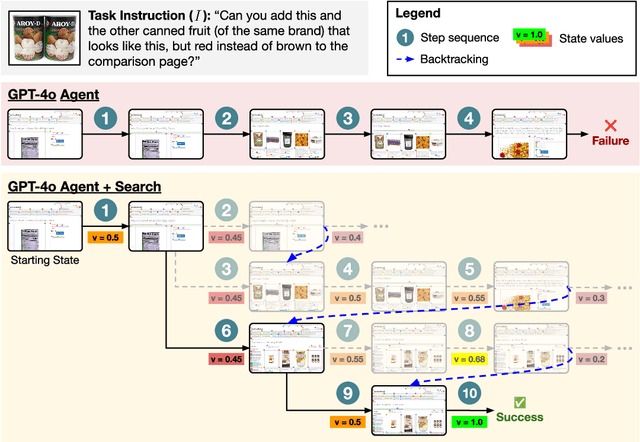


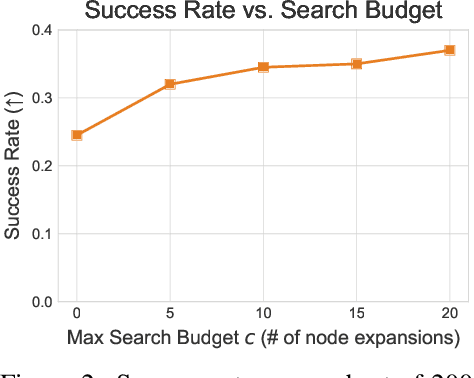
Abstract:Autonomous agents powered by language models (LMs) have demonstrated promise in their ability to perform decision-making tasks such as web automation. However, a key limitation remains: LMs, primarily optimized for natural language understanding and generation, struggle with multi-step reasoning, planning, and using environmental feedback when attempting to solve realistic computer tasks. Towards addressing this, we propose an inference-time search algorithm for LM agents to explicitly perform exploration and multi-step planning in interactive web environments. Our approach is a form of best-first tree search that operates within the actual environment space, and is complementary with most existing state-of-the-art agents. It is the first tree search algorithm for LM agents that shows effectiveness on realistic web tasks. On the challenging VisualWebArena benchmark, applying our search algorithm on top of a GPT-4o agent yields a 39.7% relative increase in success rate compared to the same baseline without search, setting a state-of-the-art success rate of 26.4%. On WebArena, search also yields a 28.0% relative improvement over a baseline agent, setting a competitive success rate of 19.2%. Our experiments highlight the effectiveness of search for web agents, and we demonstrate that performance scales with increased test-time compute. We conduct a thorough analysis of our results to highlight improvements from search, limitations, and promising directions for future work. Our code and models are publicly released at https://jykoh.com/search-agents.
Adversarial Attacks on Multimodal Agents
Jun 18, 2024Abstract:Vision-enabled language models (VLMs) are now used to build autonomous multimodal agents capable of taking actions in real environments. In this paper, we show that multimodal agents raise new safety risks, even though attacking agents is more challenging than prior attacks due to limited access to and knowledge about the environment. Our attacks use adversarial text strings to guide gradient-based perturbation over one trigger image in the environment: (1) our captioner attack attacks white-box captioners if they are used to process images into captions as additional inputs to the VLM; (2) our CLIP attack attacks a set of CLIP models jointly, which can transfer to proprietary VLMs. To evaluate the attacks, we curated VisualWebArena-Adv, a set of adversarial tasks based on VisualWebArena, an environment for web-based multimodal agent tasks. Within an L-infinity norm of $16/256$ on a single image, the captioner attack can make a captioner-augmented GPT-4V agent execute the adversarial goals with a 75% success rate. When we remove the captioner or use GPT-4V to generate its own captions, the CLIP attack can achieve success rates of 21% and 43%, respectively. Experiments on agents based on other VLMs, such as Gemini-1.5, Claude-3, and GPT-4o, show interesting differences in their robustness. Further analysis reveals several key factors contributing to the attack's success, and we also discuss the implications for defenses as well. Project page: https://chenwu.io/attack-agent Code and data: https://github.com/ChenWu98/agent-attack
OmniACT: A Dataset and Benchmark for Enabling Multimodal Generalist Autonomous Agents for Desktop and Web
Feb 28, 2024Abstract:For decades, human-computer interaction has fundamentally been manual. Even today, almost all productive work done on the computer necessitates human input at every step. Autonomous virtual agents represent an exciting step in automating many of these menial tasks. Virtual agents would empower users with limited technical proficiency to harness the full possibilities of computer systems. They could also enable the efficient streamlining of numerous computer tasks, ranging from calendar management to complex travel bookings, with minimal human intervention. In this paper, we introduce OmniACT, the first-of-a-kind dataset and benchmark for assessing an agent's capability to generate executable programs to accomplish computer tasks. Our scope extends beyond traditional web automation, covering a diverse range of desktop applications. The dataset consists of fundamental tasks such as "Play the next song", as well as longer horizon tasks such as "Send an email to John Doe mentioning the time and place to meet". Specifically, given a pair of screen image and a visually-grounded natural language task, the goal is to generate a script capable of fully executing the task. We run several strong baseline language model agents on our benchmark. The strongest baseline, GPT-4, performs the best on our benchmark However, its performance level still reaches only 15% of the human proficiency in generating executable scripts capable of completing the task, demonstrating the challenge of our task for conventional web agents. Our benchmark provides a platform to measure and evaluate the progress of language model agents in automating computer tasks and motivates future work towards building multimodal models that bridge large language models and the visual grounding of computer screens.
VisualWebArena: Evaluating Multimodal Agents on Realistic Visual Web Tasks
Jan 24, 2024Abstract:Autonomous agents capable of planning, reasoning, and executing actions on the web offer a promising avenue for automating computer tasks. However, the majority of existing benchmarks primarily focus on text-based agents, neglecting many natural tasks that require visual information to effectively solve. Given that most computer interfaces cater to human perception, visual information often augments textual data in ways that text-only models struggle to harness effectively. To bridge this gap, we introduce VisualWebArena, a benchmark designed to assess the performance of multimodal web agents on realistic \textit{visually grounded tasks}. VisualWebArena comprises of a set of diverse and complex web-based tasks that evaluate various capabilities of autonomous multimodal agents. To perform on this benchmark, agents need to accurately process image-text inputs, interpret natural language instructions, and execute actions on websites to accomplish user-defined objectives. We conduct an extensive evaluation of state-of-the-art LLM-based autonomous agents, including several multimodal models. Through extensive quantitative and qualitative analysis, we identify several limitations of text-only LLM agents, and reveal gaps in the capabilities of state-of-the-art multimodal language agents. VisualWebArena provides a framework for evaluating multimodal autonomous language agents, and offers insights towards building stronger autonomous agents for the web. Our code, baseline models, and data is publicly available at https://jykoh.com/vwa.
Multimodal Graph Learning for Generative Tasks
Oct 12, 2023



Abstract:Multimodal learning combines multiple data modalities, broadening the types and complexity of data our models can utilize: for example, from plain text to image-caption pairs. Most multimodal learning algorithms focus on modeling simple one-to-one pairs of data from two modalities, such as image-caption pairs, or audio-text pairs. However, in most real-world settings, entities of different modalities interact with each other in more complex and multifaceted ways, going beyond one-to-one mappings. We propose to represent these complex relationships as graphs, allowing us to capture data with any number of modalities, and with complex relationships between modalities that can flexibly vary from one sample to another. Toward this goal, we propose Multimodal Graph Learning (MMGL), a general and systematic framework for capturing information from multiple multimodal neighbors with relational structures among them. In particular, we focus on MMGL for generative tasks, building upon pretrained Language Models (LMs), aiming to augment their text generation with multimodal neighbor contexts. We study three research questions raised by MMGL: (1) how can we infuse multiple neighbor information into the pretrained LMs, while avoiding scalability issues? (2) how can we infuse the graph structure information among multimodal neighbors into the LMs? and (3) how can we finetune the pretrained LMs to learn from the neighbor context in a parameter-efficient manner? We conduct extensive experiments to answer these three questions on MMGL and analyze the empirical results to pave the way for future MMGL research.
Generating Images with Multimodal Language Models
May 26, 2023Abstract:We propose a method to fuse frozen text-only large language models (LLMs) with pre-trained image encoder and decoder models, by mapping between their embedding spaces. Our model demonstrates a wide suite of multimodal capabilities: image retrieval, novel image generation, and multimodal dialogue. Ours is the first approach capable of conditioning on arbitrarily interleaved image and text inputs to generate coherent image (and text) outputs. To achieve strong performance on image generation, we propose an efficient mapping network to ground the LLM to an off-the-shelf text-to-image generation model. This mapping network translates hidden representations of text into the embedding space of the visual models, enabling us to leverage the strong text representations of the LLM for visual outputs. Our approach outperforms baseline generation models on tasks with longer and more complex language. In addition to novel image generation, our model is also capable of image retrieval from a prespecified dataset, and decides whether to retrieve or generate at inference time. This is done with a learnt decision module which conditions on the hidden representations of the LLM. Our model exhibits a wider range of capabilities compared to prior multimodal language models. It can process image-and-text inputs, and produce retrieved images, generated images, and generated text -- outperforming non-LLM based generation models across several text-to-image tasks that measure context dependence.
VQ3D: Learning a 3D-Aware Generative Model on ImageNet
Feb 14, 2023


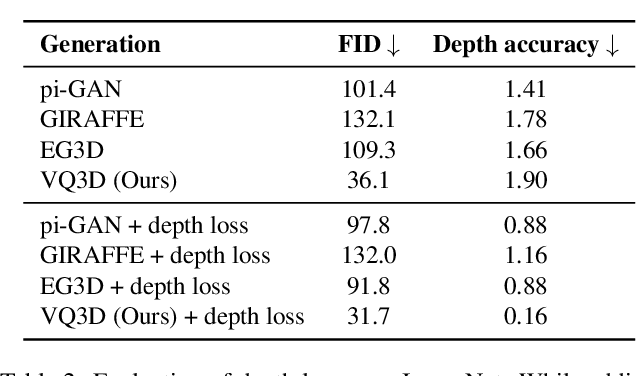
Abstract:Recent work has shown the possibility of training generative models of 3D content from 2D image collections on small datasets corresponding to a single object class, such as human faces, animal faces, or cars. However, these models struggle on larger, more complex datasets. To model diverse and unconstrained image collections such as ImageNet, we present VQ3D, which introduces a NeRF-based decoder into a two-stage vector-quantized autoencoder. Our Stage 1 allows for the reconstruction of an input image and the ability to change the camera position around the image, and our Stage 2 allows for the generation of new 3D scenes. VQ3D is capable of generating and reconstructing 3D-aware images from the 1000-class ImageNet dataset of 1.2 million training images. We achieve an ImageNet generation FID score of 16.8, compared to 69.8 for the next best baseline method.
Grounding Language Models to Images for Multimodal Generation
Jan 31, 2023Abstract:We propose an efficient method to ground pretrained text-only language models to the visual domain, enabling them to process and generate arbitrarily interleaved image-and-text data. Our method leverages the abilities of language models learnt from large scale text-only pretraining, such as in-context learning and free-form text generation. We keep the language model frozen, and finetune input and output linear layers to enable cross-modality interactions. This allows our model to process arbitrarily interleaved image-and-text inputs, and generate free-form text interleaved with retrieved images. We achieve strong zero-shot performance on grounded tasks such as contextual image retrieval and multimodal dialogue, and showcase compelling interactive abilities. Our approach works with any off-the-shelf language model and paves the way towards an effective, general solution for leveraging pretrained language models in visually grounded settings.
A New Path: Scaling Vision-and-Language Navigation with Synthetic Instructions and Imitation Learning
Oct 06, 2022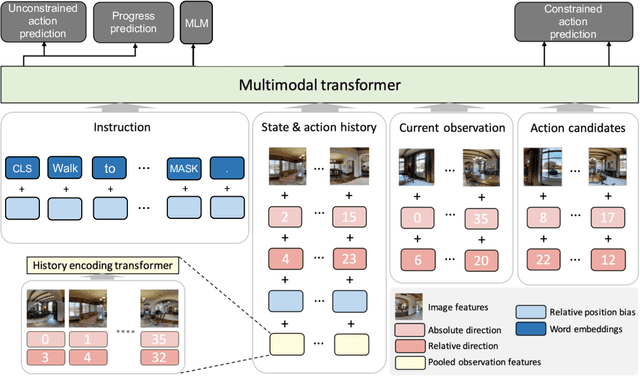

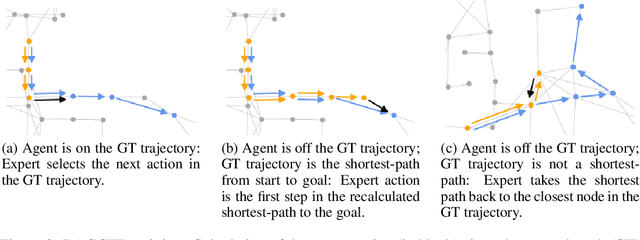
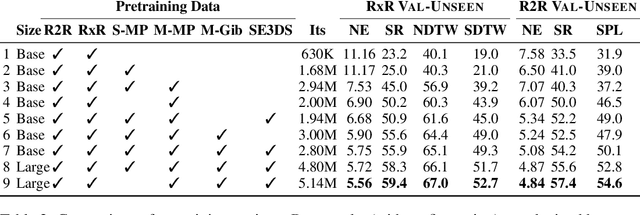
Abstract:Recent studies in Vision-and-Language Navigation (VLN) train RL agents to execute natural-language navigation instructions in photorealistic environments, as a step towards intelligent agents or robots that can follow human instructions. However, given the scarcity of human instruction data and limited diversity in the training environments, these agents still struggle with complex language grounding and spatial language understanding. Pre-training on large text and image-text datasets from the web has been extensively explored but the improvements are limited. To address the scarcity of in-domain instruction data, we investigate large-scale augmentation with synthetic instructions. We take 500+ indoor environments captured in densely-sampled 360 deg panoramas, construct navigation trajectories through these panoramas, and generate a visually-grounded instruction for each trajectory using Marky (Wang et al., 2022), a high-quality multilingual navigation instruction generator. To further increase the variability of the trajectories, we also synthesize image observations from novel viewpoints using an image-to-image GAN. The resulting dataset of 4.2M instruction-trajectory pairs is two orders of magnitude larger than existing human-annotated datasets, and contains a wider variety of environments and viewpoints. To efficiently leverage data at this scale, we train a transformer agent with imitation learning for over 700M steps of experience. On the challenging Room-across-Room dataset, our approach outperforms all existing RL agents, improving the state-of-the-art NDTW from 71.1 to 79.1 in seen environments, and from 64.6 to 66.8 in unseen test environments. Our work points to a new path to improving instruction-following agents, emphasizing large-scale imitation learning and the development of synthetic instruction generation capabilities.
Scaling Autoregressive Models for Content-Rich Text-to-Image Generation
Jun 22, 2022
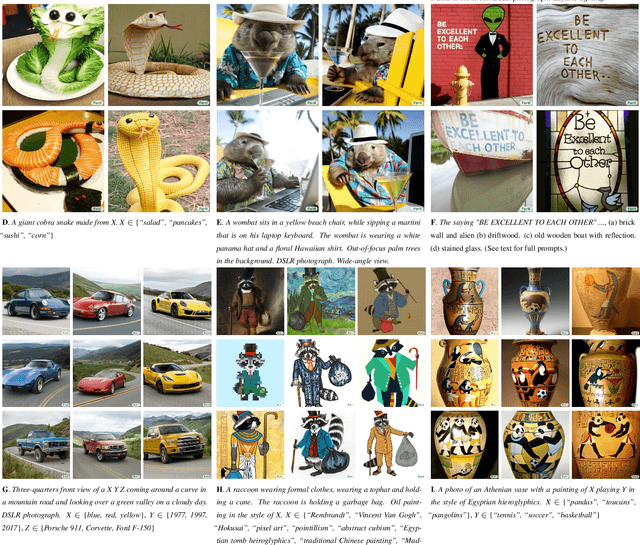

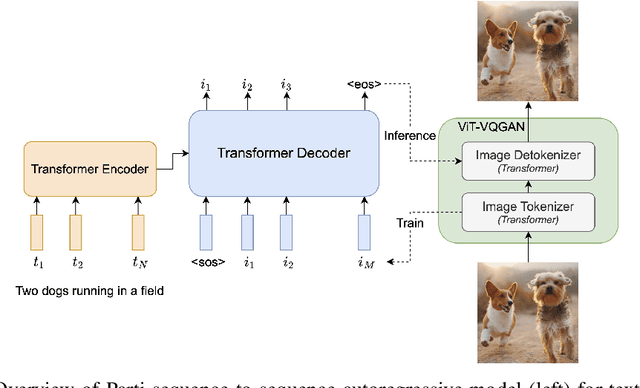
Abstract:We present the Pathways Autoregressive Text-to-Image (Parti) model, which generates high-fidelity photorealistic images and supports content-rich synthesis involving complex compositions and world knowledge. Parti treats text-to-image generation as a sequence-to-sequence modeling problem, akin to machine translation, with sequences of image tokens as the target outputs rather than text tokens in another language. This strategy can naturally tap into the rich body of prior work on large language models, which have seen continued advances in capabilities and performance through scaling data and model sizes. Our approach is simple: First, Parti uses a Transformer-based image tokenizer, ViT-VQGAN, to encode images as sequences of discrete tokens. Second, we achieve consistent quality improvements by scaling the encoder-decoder Transformer model up to 20B parameters, with a new state-of-the-art zero-shot FID score of 7.23 and finetuned FID score of 3.22 on MS-COCO. Our detailed analysis on Localized Narratives as well as PartiPrompts (P2), a new holistic benchmark of over 1600 English prompts, demonstrate the effectiveness of Parti across a wide variety of categories and difficulty aspects. We also explore and highlight limitations of our models in order to define and exemplify key areas of focus for further improvements. See https://parti.research.google/ for high-resolution images.
 Add to Chrome
Add to Chrome Add to Firefox
Add to Firefox Add to Edge
Add to Edge